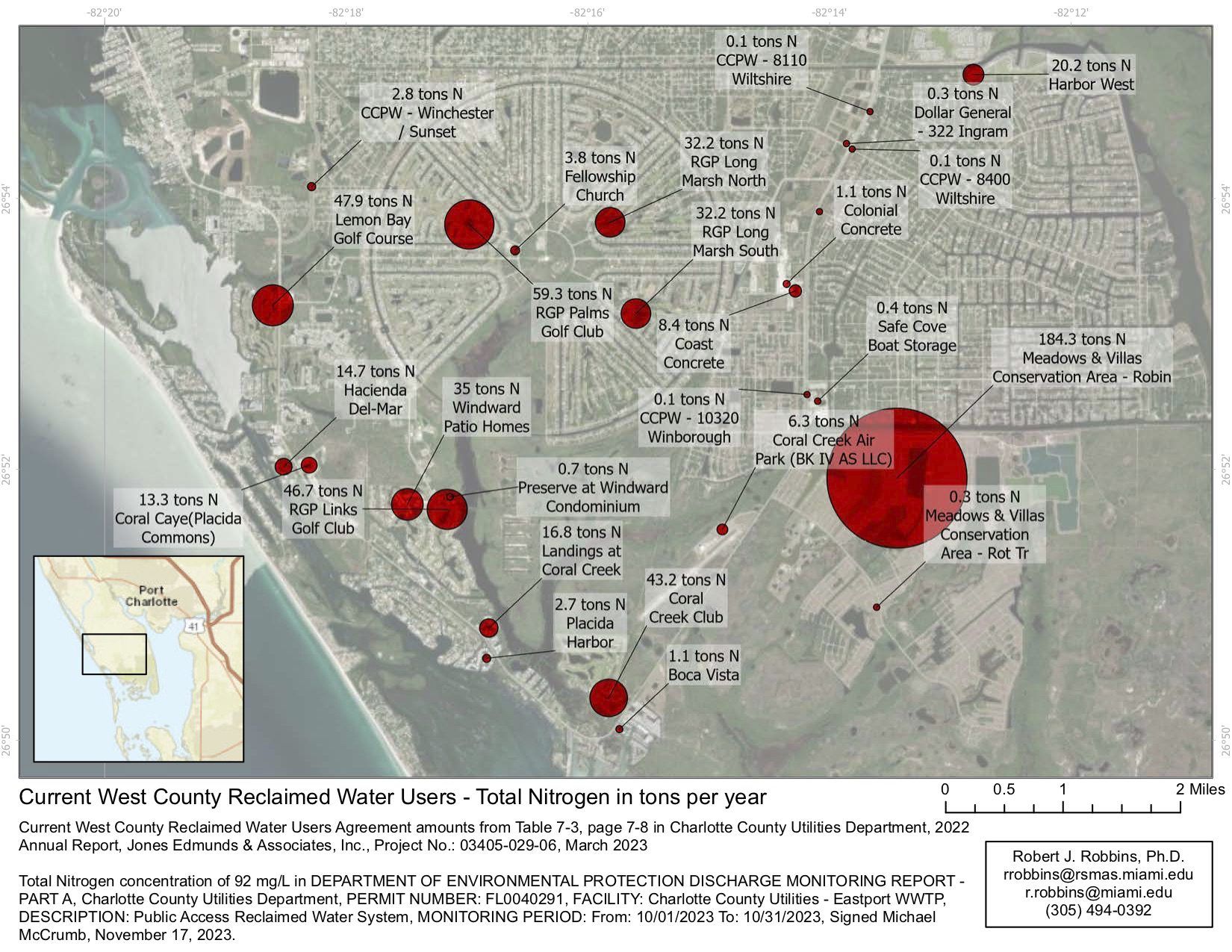Open Letter: Nitrogen no fix for Charlotte County reclaimed water

BY ROBERT J. ROBBINS PhD. and PERCY ANGELO
In large measure Charlotte County’s nitrogen problem results from its disposal of untreated reclaimed water on properties throughout the county. The county’s sewage treatment plants only provide secondary treatment. They do not remove nutrients. This means that the county’s reclaimed water has all the nutrients, including nitrogen, that were in the untreated sewage influent.
All that nitrogen is then redistributed throughout the county through its reclaimed water system to ponds and direct users located on the coasts, including Cape Haze. Simple math illustrates that the county is not only failing to reduce nitrogen loading, but is exacerbating the problem through new sewer connections and septic-to-sewer conversions.
The total nitrogen concentration in Charlotte County Utilities’ reclaimed water has been reported by county staff to be from 34.9 mg/L to as high as 92 mg/L. The reported volume of reclaimed water is typically 1.3 billion gallons annually.
This means that the county’s reclaimed water system is discharging between 190 and 500 tons of nitrogen annually to golf courses, community and condo associations, parks, churches, and various businesses for irrigation and other purposes. In fact, irrigating with the Charlotte County’s reclaimed water is just like treating the property with fertilizer; yet fertilization is barred during parts of the year precisely because of the resulting nutrient pollution.
More nitrogen jeopardizes both Lemon Bay and Charlotte Harbor and contributes to their impaired status. Both are State Aquatic Preserves, which the Florida Department of of Environmental Protection has designated as Outstanding Florida Waters.
Further, the county has a high number of sewer and reuse line breaks. These may be inevitable in a county with constant construction. (Reading the spill reports to FDEP, it is evident that construction mishaps are a frequent cause of breaks.) But because the spilled material is high in nitrogen, each break is another source of nutrient pollution. Sarasota County has already put septic system conversions on hold until Advanced Wastewater Treatment (AWT) construction is completed at its sewage treatment plants. Charlotte County should do likewise and minimize its ongoing discharge of nitrogen to the system.
The county’s blind eye to hundreds of tons of nitrogen discharged annually through reclaimed water is an expensive recipe for failure.
The county’s Sewer Master Plan objective to “reduce pollution by converting septic to sewer” does nothing to reduce nitrogen in the system. In fact, the county is dumping even more nitrogen into the system with every new septic-to-sewer connection and new housing development, all thanks to the nitrogen-rich reclaimed water system.
More nitrogen will only cause new and continued water quality impairments. This is one problem where there will necessarily be a real-world demonstration of failure. Choosing a wrong or insufficient solution (even if apparently advantageous at the time of decision) will be exposed by the required ongoing monitoring.
This doesn’t have to be the case. Charlotte County must prioritize resources toward AWT rather than septic conversions. Charlotte County Ordinance No. 2007-041 clearly defines “reclaimed water” as wastewater having received “advanced secondary treatment.”
However, none of Charlotte County’s facilities have operated with advanced treatment since the adoption of the ordinance. Florida Statute 403.086 differentiates between “advanced waste treatment” and “secondary wastewater treatment” by defining “advanced waste treatment” as treatment which will provide a reclaimed water product with a total nitrogen concentration not exceeding three mg per liter.
Florida statutes recognize that nitrogen in reclaimed water is significant and must be limited, and the county ordinance recognizes that standard secondary treatment is not sufficient. The county’s four sewage treatment plants and the reclaim water they provide are a significant part of the nitrogen problem (three mg/L requirement vs 34.7 to 92 mg/L County flows)
Charlotte County is at least three years away from having even one AWT- capable facility, and it won’t be until the next decade when all four of its facilities will finally operate at AWT standards. Until all Charlotte County facilities are converted to AWT and reclaimed water is the product of AWT processing, Charlotte County has no hope of improving its nitrogen loading to the environment, and every new septic-to-sewer conversion makes the nitrogen problem even worse.
Editor’s Note: Rob Robbins and Percy Angelo are property owners in Cape Haze. Robbins is a marine scientist and Angelo is an environmental attorney. This is an excerpt from a letter they sent to county staff and the Charlotte County Board of County Commissioners in December.
Pictured above, at top: A map of reclaimed water releases across Cape Haze.









